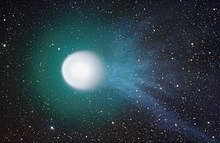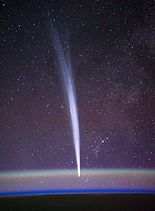Our website is made possible by displaying online advertisements to our visitors.
Please consider supporting us by disabling your ad blocker.
Comet tail
Diagram of a comet showing the dust tail, dust trail (or anti-tail), and ionized gas tail, which is formed by the solar wind flow.


A comet tail and coma are visible features of a comet when they are illuminated by the Sun and may become visible from Earth when a comet passes through the inner Solar System. As a comet approaches the inner Solar System, solar radiation causes the volatile materials within the comet to vaporize and stream out of the nucleus, carrying dust away with them.
Blown solar downwind, two separate tails are formed: one composed of dust and the other of gases. They become visible through different phenomena: the dust reflects sunlight directly, and the gases glow from ionization. Most comets are too faint to be visible without the aid of a telescope, but a few each decade become bright enough to be visible to the naked eye.
Previous Page Next Page




